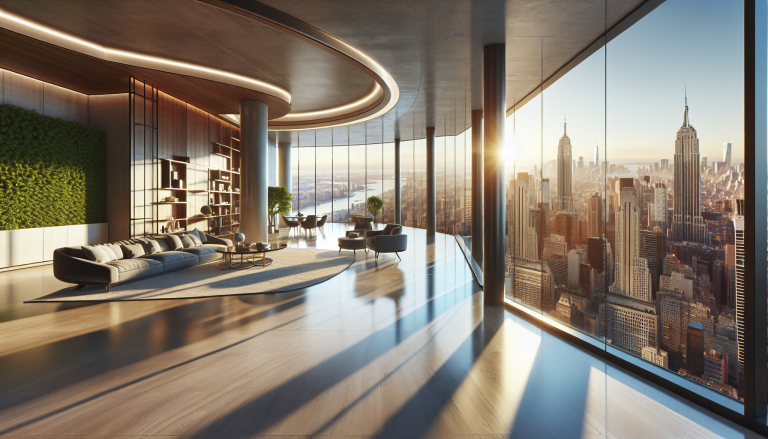9 Pivotal Economic Indicators to Watch: Unlocking Real Estate Cycles
What are pivotal economic indicators and why are they important?

In a world where stability meets unpredictability, you have the power to discern the future of your real estate investments. ‘9 Pivotal Economic Indicators to Watch: Unlocking Real Estate Cycles’ arms you with the knowledge to navigate the ebbs and flows of the property market.
You’ll learn how interest rates and employment trends can signal shifts in the housing landscape, and why government policies might affect your freedom to buy or sell. By keeping an eye on construction activity, GDP changes, and stock market correlations, as well as key indicators like NAHB HMI, housing starts, building permits, existing home sales, new home sales, and data reports from the Census Bureau and the Department of Housing and Urban Development (HUD), including the “Monthly New Residential Construction” report, commonly referred to as “housing starts”, you’re not just following the numbers; you’re charting a course toward financial autonomy.
Understand rental yields and consumer confidence to make moves that align with your aspirations for liberty and prosperity. This guide is your compass to mastering the cycles that drive real estate fortunes.
Interest Rate Influence
https://www.youtube.com/embed/K6bAX4Tk6t4
Interest rates directly affect your mortgage costs and real estate investment returns. When you’re eyeing freedom through property ownership, understanding this dynamic is crucial. Low interest rates can unlock the door to more affordable mortgage rates, making it easier for you to leap into the market or expand your portfolio. They stir a sense of opportunity, driving demand and potentially inflating property values. The Federal Reserve, the central bank of the US, holds regularly-scheduled meetings eight times a year to discuss and potentially adjust the federal interest rate through the Federal Open Market Committee (FOMC). These decisions can have a significant impact on borrowing costs for individuals and businesses, and can influence the overall health of the economy, making it a crucial indicator to watch for on Wall Street and in real estate cycles.
On the flip side, high interest rates can tighten that same door’s hinge. Your monthly payments on new loans climb, and the cost of borrowing eats into your potential gains. It’s a signal to tread carefully, as the market may cool and prices could stabilize or even dip.
As an investor or homebuyer, you’ve got to keep a pulse on these rates. They’re not just numbers—they’re your roadmap to making smarter decisions that align with your vision of financial independence. Whether rates are falling into the low interest oasis or climbing the high interest rate mountain, your strategy must adapt to changes in the federal funds rate, which is regularly announced by the Federal Reserve.

Keep an eye on the horizon, and let the winds of interest rates sail you towards successful real estate ventures.
Employment Growth Trends
You’ll find that employment growth trends are one of the most telling indicators when predicting the ebb and flow of real estate cycles. When you’re eyeing freedom in your investments, understanding the job market gives you the power to anticipate changes.
A robust job market signals a thriving economy, potentially leading to an uptick in property demand and higher real estate values. In contrast, if employment growth is slowing, it could be a red flag for the property market, suggesting you might need to brace for a dip in demand and possibly softer property prices. As one of the most important economic indicators, labor market trends, including nonfarm payrolls and the unemployment rate from the U.S. Department of Labor’s Bureau of Labor Statistics (BLS), can greatly impact the securities markets. As such, they should be closely monitored by investors and industry professionals to make informed decisions about their investments and navigate the ever-changing economic landscape. This includes keeping a close eye on the number of jobs created each month through the BLS’s monthly survey, known as nonfarm payrolls, to gauge the overall health of the job market and its potential impact on the real estate market. Additionally, the percentage figure representing the proportion of Americans who are not employed and actively seeking work, as determined by the monthly survey of 60,000 households, is also a crucial factor to consider in understanding employment growth trends for general government employees and private households.
By keeping your finger on the pulse of current economic conditions, you’re better equipped to make informed decisions. Employment growth trends, such as robust growth in job creation and steady job growth, as well as economic growth, aren’t just numbers; they’re forecasts of potential shifts in the real estate market that can affect your financial freedom. Whether you’re looking to buy, sell, or hold, analyzing these trends empowers you to navigate the market with confidence. Keep an eye on economic growth as it can have a significant impact on employment and the real estate market.

Housing Market Dynamics
Consistently observing housing market dynamics gives you a clearer picture of how employment trends directly influence property demand and prices. You’re not just buying a home; you’re investing in a slice of the economy.
Monitoring the housing starts—a leading indicator of economic health—can signal the future of the housing market. A spike in starts often means builders are bullish, anticipating increased demand for property.
But it’s not just about construction. Pay attention to the ripples caused by government action. Subsidies and legislation can either bolster your freedom to invest or tie you down with regulations. You’ve got to stay ahead of these changes to spot real opportunities.
Remember, demographics dictate demand. The age and composition of the population can forecast who’s buying and who’s selling, which directly affects your strategy. And don’t ignore the silent thief—inflation. Rising prices can erode your purchasing power but also inflate property values, affecting both residential homes and rentals.

Lastly, currency exchange ratios can swing the door wide open—or slam it shut—on foreign investment, reshaping the housing market landscape. Stay informed, stay free, and let these indicators guide your real estate decisions.
Consumer Confidence Levels
You need to keep an eye on consumer confidence levels as they’re a key indicator of spending behavior, which directly impacts the real estate market.
If people feel optimistic about their financial future, they’re more likely to invest in property, driving prices up.
Conversely, when confidence wanes, you’ll often see a cooling effect on pricing and demand.

Spending Behavior Impact
Consumer confidence levels directly influence your real estate investment decisions as they shape buyers’ and renters’ spending behaviors. When Consumer Confidence is high, people are more likely to dive into the housing market, driving up demand and potentially boosting property values. You can almost feel the market pulse with optimism, signaling a robust period where your investments might flourish.
On the flip side, if confidence wanes, you’ll notice a chilling effect. Spending tightens, and the once-busy market might slow to a crawl. It’s like a cautionary tale, reminding you to gauge the overall health of the economy before making your move. Stay ahead by tracking this vital sign, ensuring your real estate ventures navigate towards liberty and prosperity.
Confidence Influences Pricing
Market stability hinges on consumer confidence, which in turn can significantly sway real estate pricing you’ll encounter. When people feel secure about their financial future, they’re more likely to invest in property, driving prices up. Conversely, a dip in confidence can lead to a cautious approach, stagnating or even reducing property prices.
As you navigate the real estate market, keeping an eye on the Consumer Confidence Index (CCI) from the Conference Board is vital. This index, released monthly by the Conference Board, forecasts the economic cycle’s twists and turns, allowing you to anticipate shifts in demand. Additionally, the U.S. Census Bureau’s retail sales report, released around the 13th of each month, can also provide valuable insights into consumer spending and potential future changes in CPI numbers. Don’t overlook these indicators—they’re powerful tools in your arsenal for understanding when and where to assert your freedom to make moves in the market. The Consumer Price Index (CPI) and Producer Price Index (PPI) are two important measures to keep track of, as they reflect changes in the prices of goods and services from both the consumer and producer perspectives. These indexes can give valuable insights into inflation and the overall state of the economy for urban consumers. The PPI, in particular, is a timely measure as it is the first inflation measure available in the month, making it a useful tool for predicting inflation at the wholesale level.

Stay ahead by monitoring consumer sentiment; it’s a clear signal of the real estate climate.
Construction Activity Insights
You need to keep a close eye on building permits trends and residential development rates to grasp the ebb and flow of construction activity. These metrics give you a sneak peek into the market’s future, as they’re often the first to signal shifts in real estate cycles.
Building Permits Trends
Analyzing the number of building permits issued gives you a clear picture of upcoming construction trends and their impact on real estate cycles. As you pursue the freedom to carve your own path, understanding this data is crucial.
A surge in permits signals a robust expansion phase, brimming with new construction projects. This uptrend not only reflects economic vitality but also heralds a wealth of investment opportunities for you. It’s a green light for developers and investors alike, indicating the market’s readiness to support growth.

Conversely, a dip in permit activity can signal a tightening market. Keep your eyes peeled on these trends—they’re your compass to navigating the real estate landscape and seizing the reins on your financial future.
Residential Development Rates
Considering residential development rates, you’ll gain valuable insights into the construction activities that significantly shape real estate cycles. These rates are among the important economic indicators that reveal a story of expansion and contraction within the housing market.
By keeping a pulse on residential development rates, you’re tapping into early signs of market conditions, allowing you to forecast opportunities or prepare for downturns.
It’s essential to understand how these rates ebb and flow with mortgage interest rates and government policies, which are key to your strategic freedom in the market.

Stay informed and agile; residential development rates can guide your decisions, helping you navigate through the ever-changing landscape of real estate with confidence and foresight.
GDP Fluctuations Impact
Understanding the full extent of GDP’s influence on the real estate market is essential for your investment strategy. As GDP ebbs and flows, so do the fortunes of property markets. When GDP is booming, you’ll often see a surge in consumer spending and employment rates, which in turn can boost demand for both residential and commercial real estate. Conversely, a contracting GDP can tighten consumers’ belts, leading to a drop in demand and potentially lower property values. Additionally, the market’s response to GDP fluctuations is not solely dependent on whether the real GDP increases or decreases, but also on how any one quarterly real GDP measure compares to prior quarters and how the actual real GDP compares to economists’ expectations and forecasts, which are reported by the U.S. Department of Commerce’s Bureau of Economic Analysis. These price changes, also known as inflation, can greatly impact the real estate market and should be closely monitored by investors.
Keeping your finger on the pulse of GDP fluctuations isn’t just wise—it’s a strategic move that can set you free from the constraints of a volatile market. By monitoring these changes, you’re better equipped to predict future market trends, preparing you to make moves when the time is right.
Rental Yield Patterns
You’ll need to monitor nine key economic indicators to grasp how rental yield patterns can impact your real estate investments. As a go-getter in the realm of successful real estate, you’re not just playing the game; you’re strategizing to win. Keeping an eye on interest rates is crucial. When they dip, more folks rush to buy, potentially boosting both property values and rental yields. That’s a sweet spot you don’t want to miss.

Inflation rates are your stealthy opponents. They can stealthily eat into your profits by hiking up property costs. But here’s a pro tip: investors make the most of such times by adjusting rents accordingly, ensuring your cash flow remains robust.
Currency exchange ratios are like the wild cards of the deck. In locales teeming with expats, swings in currency values can shift rental demand and affect your yields. You’ve got to stay sharp and adaptive.
Let’s not forget tax deductions; they’re the power moves in your playbook. They can significantly alter your post-tax rental yield, effectively raising the bar for what you pocket at the end of the day. In your quest for freedom, understanding these indicators isn’t just smart—it’s your key to unlocking true financial liberation.
Government Policy Effects
Diving into government policy effects, you’ll see how shifts in legislation and subsidies can directly steer the real estate market’s trajectory. Grasp the significance of tax credits in your financial planning, and you’ll unlock a world where you’re not just reacting to the market—you’re anticipating its moves. These government policy effects, analyzed and reported by various organizations and government agencies, aren’t just dry regulations; they’re the rudder guiding the market’s course, often with the intent of promoting homeownership or revitalizing certain areas.

By keeping a pulse on these changes, you’re positioning yourself to capitalize on the freedoms afforded by timely knowledge. It’s about understanding how a new housing bill might increase demand in a sleepy neighborhood or how a change in tax law could make your next investment significantly more profitable. Recognize that subsidies are more than just handouts; they’re strategic tools that can create lucrative opportunities for savvy investors like you.
Stay alert to these government policy effects. They can shift the ground beneath your feet, but with the right financial planning, they also pave golden paths towards achieving your financial goals. It’s not just about finding a place to call home; it’s about discovering where freedom and opportunity intersect in the dynamic landscape of real estate.
Stock Market Correlations
Your portfolio’s performance may reflect broader economic trends, with the stock market often serving as a bellwether for real estate market swings. Observing stock market correlations can empower you with insights that might signal when to act boldly or proceed with caution in the property arena. Consider this: when equities rally, there’s a sense of wealth and optimism that can fuel real estate demand, pushing prices up. Conversely, a significant drop in the stock market, also known as a bear market, can dampen consumer confidence and lead to a decrease in real estate demand, resulting in a decline in stock prices.
Understanding these correlations will enable you to navigate through the tumult of economic shifts with greater ease. For instance, if you’re tracking market indexes, noticing a stock trading at a multi-year high could indicate an upcoming surge in luxury real estate purchases, as it may be a reflection of positive trends in the global economy. It’s about recognizing patterns; the ebb and flow of 32 key market indexes can profoundly influence the real estate sector.

Keep an eye on currency exchange ratios as well. If you’re eyeing international property or markets with a high expat presence, these ratios are crucial. A stronger dollar might mean more Americans buying abroad, affecting prices and demand.
Frequently Asked Questions
Which Economic Indicator Should Be Monitored to Analyze the Residential Real Estate Market?
You should monitor interest rates, construction activity, and population growth to analyze the residential real estate market, ensuring you’re free to make informed decisions and capitalize on investment opportunities.
What Phase of the Real Estate Cycle Are We in 2023?
You’re riding the wave of a stable real estate cycle in 2023, buoyed by market sentiment, policy impact, and global trends that suggest growth and equilibrium. So, seize your chance to invest or nest!
What Are the Real Estate Economic Cycles?
You’ll navigate real estate cycles by tracking market fluctuations, seizing investment opportunities, and watching construction trends. Embrace this knowledge to freely capitalize on property values as they rise and fall.
What Are the 8 Economic Indicators?
You’ll find housing starts trends, mortgage rate impacts, and construction cost analysis crucial in grasping the 8 economic indicators. They’ll guide your liberty to make informed decisions in the ever-changing real estate landscape.
Conclusion
Navigating the real estate market is like riding a wave. By attentively watching these nine economic indicators, you’re tuning into the rhythm of the ocean. You’ll catch the perfect swell of opportunity by understanding interest rates, employment patterns, and government policies.
Keep your eyes peeled on market dynamics and ride the crest of informed decisions, ensuring you don’t wipe out when the tides of change roll in.
Stay vigilant, and you’ll surf your way to success.
In a world where stability meets unpredictability, you have the power to discern the future of your real estate investments. ‘Unlocking Real Estate Cycles: 9 Pivotal Economic Indicators to Watch’ arms you with the knowledge to navigate the ebbs and flows of the property market.
You’ll learn how interest rates and employment trends can signal shifts in the housing landscape, and why government policies might affect your freedom to buy or sell. By keeping an eye on construction activity, GDP changes, and stock market correlations, you’re not just following the numbers; you’re charting a course toward financial autonomy.
Understand rental yields and consumer confidence to make moves that align with your aspirations for liberty and prosperity. This guide is your compass to mastering the cycles that drive real estate fortunes.
Interest Rate Influence
Interest rates directly affect your mortgage costs and real estate investment returns. When you’re eyeing freedom through property ownership, understanding this dynamic is crucial. Low interest rates can unlock the door to more affordable mortgage rates, making it easier for you to leap into the market or expand your portfolio. They stir a sense of opportunity, driving demand and potentially inflating property values.
On the flip side, high interest rates can tighten that same door’s hinge. Your monthly payments on new loans climb, and the cost of borrowing eats into your potential gains. It’s a signal to tread carefully, as the market may cool and prices could stabilize or even dip.
As an investor or homebuyer, you’ve got to keep a pulse on these rates. They’re not just numbers—they’re your roadmap to making smarter decisions that align with your vision of financial independence. Whether rates are falling into the low interest oasis or climbing the high interest rate mountain, your strategy must adapt.

Keep an eye on the horizon, and let the winds of interest rates sail you towards successful real estate ventures.
Employment Growth Trends
You’ll find that employment growth trends are one of the most telling indicators when predicting the ebb and flow of real estate cycles. When you’re eyeing freedom in your investments, understanding the job market gives you the power to anticipate changes.
A robust job market signals a thriving economy, potentially leading to an uptick in property demand and higher real estate values. In contrast, if employment growth is slowing, it could be a red flag for the property market, suggesting you might need to brace for a dip in demand and possibly softer property prices.
By keeping your finger on the pulse of current economic conditions, you’re better equipped to make informed decisions. Employment growth trends aren’t just numbers; they’re forecasts of potential shifts in the real estate market that can affect your financial freedom. Whether you’re looking to buy, sell, or hold, analyzing these trends empowers you to navigate the market with confidence.

Housing Market Dynamics
Consistently observing housing market dynamics gives you a clearer picture of how employment trends directly influence property demand and prices. You’re not just buying a home; you’re investing in a slice of the economy.
Monitoring the housing starts—a leading indicator of economic health—can signal the future of the housing market. A spike in starts often means builders are bullish, anticipating increased demand for property.
But it’s not just about construction. Pay attention to the ripples caused by government action. Subsidies and legislation can either bolster your freedom to invest or tie you down with regulations. You’ve got to stay ahead of these changes to spot real opportunities.
Remember, demographics dictate demand. The age and composition of the population can forecast who’s buying and who’s selling, which directly affects your strategy. And don’t ignore the silent thief—inflation. Rising prices can erode your purchasing power but also inflate property values, affecting both residential homes and rentals.

Lastly, currency exchange ratios can swing the door wide open—or slam it shut—on foreign investment, reshaping the housing market landscape. Stay informed, stay free, and let these indicators guide your real estate decisions.
Consumer Confidence Levels
You need to keep an eye on consumer confidence levels as they’re a key indicator of spending behavior, which directly impacts the real estate market.
If people feel optimistic about their financial future, they’re more likely to invest in property, driving prices up.
Conversely, when confidence wanes, you’ll often see a cooling effect on pricing and demand.

Spending Behavior Impact
Consumer confidence levels directly influence your real estate investment decisions as they shape buyers’ and renters’ spending behaviors. When Consumer Confidence is high, people are more likely to dive into the housing market, driving up demand and potentially boosting property values. You can almost feel the market pulse with optimism, signaling a robust period where your investments might flourish.
On the flip side, if confidence wanes, you’ll notice a chilling effect. Spending tightens, and the once-busy market might slow to a crawl. It’s like a cautionary tale, reminding you to gauge the overall health of the economy before making your move. Stay ahead by tracking this vital sign, ensuring your real estate ventures navigate towards liberty and prosperity.
Confidence Influences Pricing
Market stability hinges on consumer confidence, which in turn can significantly sway real estate pricing you’ll encounter. When people feel secure about their financial future, they’re more likely to invest in property, driving prices up. Conversely, a dip in confidence can lead to a cautious approach, stagnating or even reducing property prices.
As you navigate the real estate market, keeping an eye on the Consumer Confidence Index (CCI) is vital. This index forecasts the economic cycle’s twists and turns, allowing you to anticipate shifts in demand. Don’t overlook this indicator—it’s a powerful tool in your arsenal for understanding when and where to assert your freedom to make moves in the market.

Stay ahead by monitoring consumer sentiment; it’s a clear signal of the real estate climate.
Construction Activity Insights
You need to keep a close eye on building permits trends and residential development rates to grasp the ebb and flow of construction activity. These metrics give you a sneak peek into the market’s future, as they’re often the first to signal shifts in real estate cycles.
Building Permits Trends
Analyzing the number of building permits issued gives you a clear picture of upcoming construction trends and their impact on real estate cycles. As you pursue the freedom to carve your own path, understanding this data is crucial.
A surge in permits signals a robust expansion phase, brimming with new construction projects. This uptrend not only reflects economic vitality but also heralds a wealth of investment opportunities for you. It’s a green light for developers and investors alike, indicating the market’s readiness to support growth.

Conversely, a dip in permit activity can signal a tightening market. Keep your eyes peeled on these trends—they’re your compass to navigating the real estate landscape and seizing the reins on your financial future.
Residential Development Rates
Considering residential development rates, you’ll gain valuable insights into the construction activities that significantly shape real estate cycles. These rates are among the important economic indicators that reveal a story of expansion and contraction within the housing market.
By keeping a pulse on residential development rates, you’re tapping into early signs of market conditions, allowing you to forecast opportunities or prepare for downturns.
It’s essential to understand how these rates ebb and flow with mortgage interest rates and government policies, which are key to your strategic freedom in the market.

Stay informed and agile; residential development rates can guide your decisions, helping you navigate through the ever-changing landscape of real estate with confidence and foresight.
GDP Fluctuations Impact
Understanding the full extent of GDP’s influence on the real estate market is essential for your investment strategy. As GDP ebbs and flows, so do the fortunes of property markets. When GDP is booming, you’ll often see a surge in consumer spending and employment rates, which in turn can boost demand for both residential and commercial real estate. Conversely, a contracting GDP can tighten consumers’ belts, leading to a drop in demand and potentially lower property values.
Keeping your finger on the pulse of GDP fluctuations isn’t just wise—it’s a strategic move that can set you free from the constraints of a volatile market. By monitoring these changes, you’re better equipped to predict future market trends, preparing you to make moves when the time is right.
Rental Yield Patterns
You’ll need to monitor nine key economic indicators to grasp how rental yield patterns can impact your real estate investments. As a go-getter in the realm of successful real estate, you’re not just playing the game; you’re strategizing to win. Keeping an eye on interest rates is crucial. When they dip, more folks rush to buy, potentially boosting both property values and rental yields. That’s a sweet spot you don’t want to miss.

Inflation rates are your stealthy opponents. They can stealthily eat into your profits by hiking up property costs. But here’s a pro tip: investors make the most of such times by adjusting rents accordingly, ensuring your cash flow remains robust.
Currency exchange ratios are like the wild cards of the deck. In locales teeming with expats, swings in currency values can shift rental demand and affect your yields. You’ve got to stay sharp and adaptive.
Let’s not forget tax deductions; they’re the power moves in your playbook. They can significantly alter your post-tax rental yield, effectively raising the bar for what you pocket at the end of the day. In your quest for freedom, understanding these indicators isn’t just smart—it’s your key to unlocking true financial liberation.
Government Policy Effects
Diving into government policy effects, you’ll see how shifts in legislation and subsidies can directly steer the real estate market’s trajectory. Grasp the significance of tax credits in your financial planning, and you’ll unlock a world where you’re not just reacting to the market—you’re anticipating its moves. These government policy effects aren’t just dry regulations; they’re the rudder guiding the market’s course, often with the intent of promoting homeownership or revitalizing certain areas.

By keeping a pulse on these changes, you’re positioning yourself to capitalize on the freedoms afforded by timely knowledge. It’s about understanding how a new housing bill might increase demand in a sleepy neighborhood or how a change in tax law could make your next investment significantly more profitable. Recognize that subsidies are more than just handouts; they’re strategic tools that can create lucrative opportunities for savvy investors like you.
Stay alert to these government policy effects. They can shift the ground beneath your feet, but with the right financial planning, they also pave golden paths. It’s not just about finding a place to call home; it’s about discovering where freedom and opportunity intersect in the dynamic landscape of real estate.
Stock Market Correlations
Your portfolio’s performance may reflect broader economic trends, with the stock market often serving as a bellwether for real estate market swings. Observing stock market correlations can empower you with insights that might signal when to act boldly or proceed with caution in the property arena. Consider this: when equities rally, there’s a sense of wealth and optimism that can fuel real estate demand, pushing prices up. Conversely, a significant drop in the stock market may dampen consumer confidence, which can spill over into the housing market.
Understanding these correlations will enable you to navigate through the tumult of economic shifts with greater ease. For instance, if you’re tracking market indexes, noticing a stock trading at a multi-year high could indicate an upcoming surge in luxury real estate purchases. It’s about recognizing patterns; the ebb and flow of 32 key market indexes can profoundly influence the real estate sector.

Keep an eye on currency exchange ratios as well. If you’re eyeing international property or markets with a high expat presence, these ratios are crucial. A stronger dollar might mean more Americans buying abroad, affecting prices and demand.
Frequently Asked Questions
Which Economic Indicator Should Be Monitored to Analyze the Residential Real Estate Market?
You should monitor interest rates, construction activity, and population growth to analyze the residential real estate market, ensuring you’re free to make informed decisions and capitalize on investment opportunities.
What Phase of the Real Estate Cycle Are We in 2023?
You’re riding the wave of a stable real estate cycle in 2023, buoyed by market sentiment, policy impact, and global trends that suggest growth and equilibrium. So, seize your chance to invest or nest!
What Are the Real Estate Economic Cycles?
You’ll navigate real estate cycles by tracking market fluctuations, seizing investment opportunities, and watching construction trends. Embrace this knowledge to freely capitalize on property values as they rise and fall.
What Are the 8 Economic Indicators?
You’ll find housing starts trends, mortgage rate impacts, and construction cost analysis crucial in grasping the 8 economic indicators. They’ll guide your liberty to make informed decisions in the ever-changing real estate landscape.
Conclusion
Navigating the real estate market is like riding a wave. By attentively watching these nine economic indicators, you’re tuning into the rhythm of the ocean. You’ll catch the perfect swell of opportunity by understanding interest rates, employment patterns, and government policies.
Keep your eyes peeled on market dynamics and ride the crest of informed decisions, ensuring you don’t wipe out when the tides of change roll in.
Stay vigilant, and you’ll surf your way to success.








3 Comments
Comments are closed.